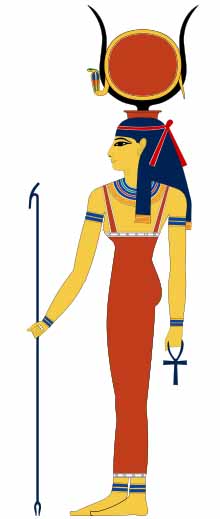

Hathor is an Ancient Egyptian goddess who personified the principles of love, beauty, music, dance, motherhood and joy. She was one of the most important and popular deities throughout the history of Ancient Egypt. Hathor was worshiped by Royalty and common people alike in whose tombs she is depicted as "Mistress of the West" welcoming the dead into the next life. In other roles she was a goddess of music, dance, foreign lands and fertility who helped women in childbirth, as well as the patron goddess of miners.
The cult of Hathor pre-dates the historical period and the roots of devotion to her are, therefore, difficult to trace, though it may be a development of predynastic cults who venerated the fertility, and nature in general, represented by cows.
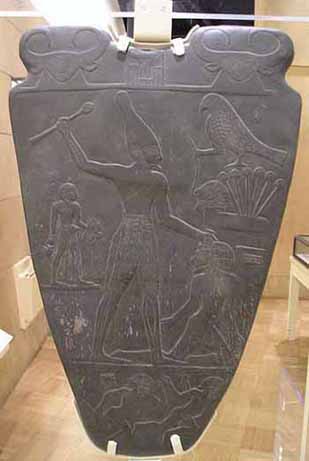
The Narmer Palette, thought to mark the unification of Upper and Lower Egypt;
note the images of Hathor at the top and bottom, as well as the lionesses,
symbols of Sekhmet, forming the central intertwined image
Hathor is commonly depicted as a cow goddess with head horns in which is set a sun disk with Uraeus. Twin feathers are also sometimes shown in later periods as well as a menat, the turquoise musical necklace often worn by women. Hathor may be the cow goddess who is depicted from an early date on the Narmer Palette and on a stone urn dating from the 1st dynasty that suggests a role as sky-goddess and a relationship to Horus who, as a sun god, is "housed" in her.
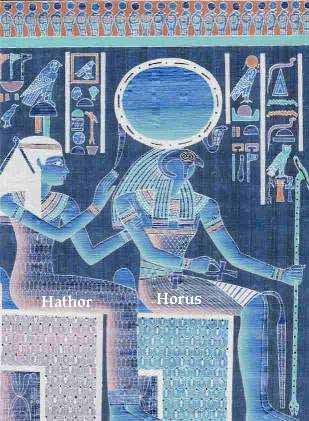
The Ancient Egyptians viewed reality as multi-layered in which deities who merge for various reasons, while retaining divergent attributes and myths, were not seen as contradictory but complementary In a complicated relationship Hathor is at times the mother, daughter and wife of Ra and, like Isis, is at times described as the mother of Horus, and associated with Bast.
The cult of Osiris promised eternal life to those deemed morally worthy. Originally the justified dead, male or female, became an Osiris but by early Roman times females became identified with Hathor and men with Osiris.
The Ancient Greeks identified Hathor with the goddess Aphrodite and the Romans as Venus.
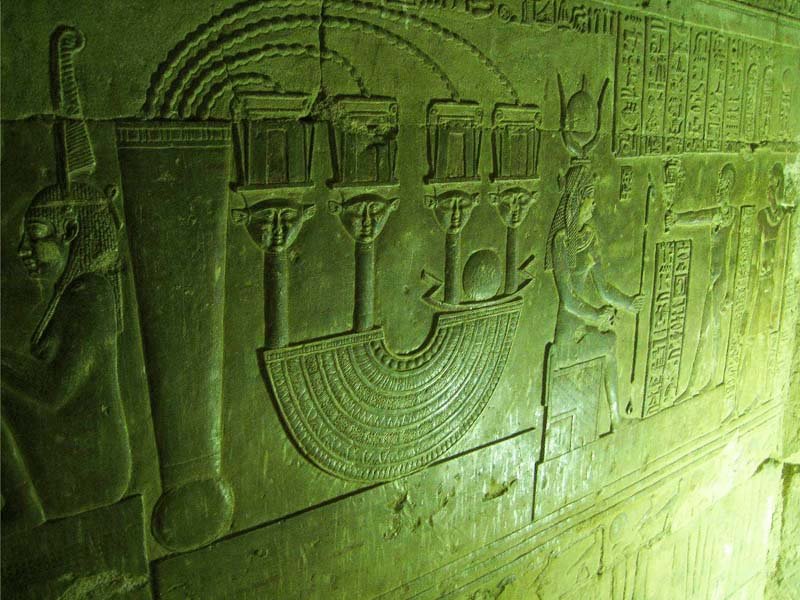
The depiction of Hathor's sacred menat necklace details the heavy semi-circular pectoral that hung from four sistra pendants. Chains attached to these pendants linked the necklace with its counterweight that hung down the back of the wearer. The necklace on the wall probably reproduces the actual necklace worn during the temple's holy rites and one of the most important objects stored underground.
Sculpture of Hathor as a cow, with all of her symbols,
As Hathor's cult developed from prehistoric cow cults it is not possible to say conclusively where devotion to her first took place. Dendera in Upper Egypt was a significant early site where she was worshiped as "Mistress of Dendera". From the Old Kingdom era she had cult sites in Meir and Kusae with the Giza-Saqqara area perhaps being the centre of devotion. At the start of the first Intermediate period Dendera appears to have become the main cult site where she was considered to be the mother as well as the consort of "Horus of Edfu". Deir el-Bahri, on the west bank of Thebes, was also an important site of Hathor that developed from a pre-existing cow cult.
Temples (and chapels) dedicated to Hathor:
The Temple of Hathor and Ma'at at Deir el-Medina, West Bank, Luxor.
The Temple of Hathor at Philae Island, Aswan.
The Hathor Chapel at the Mortuary Temple of Queen Hatshepsut West Bank, Luxor.
Hathor Temple in Abu Simbel consecrate from Ramses II
Hathor had a complex relationship with Ra. At times she is the eye of Ra and considered his daughter, but she is also considered Ra's mother. She absorbed this role from another cow goddess 'Mht wrt' ("Great flood") who was the mother of Ra in a creation myth and carried him between her horns. As a mother she gave birth to Ra each morning on the eastern horizon and as wife she conceives through union with him each day.
Hathor, along with the goddess Nut, was associated with the Milky Way Galaxy during the third millennium B.C. when, during the fall and spring equinoxes, it aligned over and touched the earth where the sun rose and fell. The four legs of the celestial cow represented Nut or Hathor could, in one account, be seen as the pillars on which the sky was supported with the stars on their bellies constituting the milky way on which the solar barque of Ra, representing the sun, sailed.
The Milky Way was seen as a waterway in the heavens, sailed upon by both the sun deity and the moon, leading the ancient Egyptians to describe it as The Nile in the Sky. Due to this, and the name mehturt, she was identified as responsible for the yearly inundation of the Nile. Another consequence of this name is that she was seen as a herald of imminent birth, as when the amniotic sac breaks and floods its waters, it is a medical indicator that the child is due to be born extremely soon. Another interpretation of the Milky Way was that it was the primal snake, Wadjet, the protector of Egypt who was closely associated with Hathor and other early deities among the various aspects of the great mother goddess, including Mut and Naunet. Hathor also was favored as a protector in desert regions.
Hathor's identity as a cow, perhaps depicted as such on the Narmer Palette, meant that she became identified with another ancient cow-goddess of fertility, Bat. It still remains an unanswered question amongst Egyptologists as to why Bat survived as an independent goddess for so long. Bat was, in some respects, connected to the Ba, an aspect of the soul, and so Hathor gained an association with the afterlife. It was said that, with her motherly character, Hathor greeted the souls of the dead in Duat, and proffered them with refreshments of food and drink. She also was described sometimes as mistress of the necropolis.
The assimilation of Bat, who was associated with the sistrum, a musical instrument, brought with it an association with music. In this later form, Hathor's cult became centered in Dendera in Upper Egypt and it was led by priestesses and priests who also were dancers, singers and other entertainers.
Essentially, Hathor had become a goddess of joy, and so she was deeply loved by the general population, and truly revered by women, who aspired to embody her multifaceted role as wife, mother, and lover. In this capacity, she gained the titles of Lady of the House of Jubilation, and The One Who Fills the Sanctuary with Joy. The worship of Hathor was so popular that a lot of festivals were dedicated to her honor than any other Egyptian deity, and more children were named after this goddess than any other deity. Even Hathor's priesthood was unusual, in that both women and men became her priests.
The Middle Kingdom was founded when Upper Egypt's pharaoh, Mentuhotep II, took control over Lower Egypt, which had become independent during the First Intermediate Period, by force. This unification had been achieved by a brutal war that was to last some twenty-eight years with many casualties, but when it ceased, calm returned, and the reign of the next pharaoh, Mentuhotep III, was peaceful, and Egypt once again became prosperous. A tale, (see "The Book of the Heavenly Cow"), from the perspective of Lower Egypt, developed around this experience of protracted war. In the tale following the war, Ra (representing the pharaoh of Upper Egypt) was no longer respected by the people (of Lower Egypt) and they ceased to obey his authority.
The myth states that Ra communicated through Hathor's third Eye (Maat) and told her that some people in the land were planning to assassinate him. Hathor was so angry that the people she had created would be audacious enough to plan that, that she became Sekhmet (war goddess of Upper Egypt) to destroy them. Hathor (as Sekhmet) became bloodthirsty and the slaughter was great because she could not be stopped. As the slaughter continued, Ra saw the chaos down below and decided to stop the blood-thirsty Sekhmet. So he poured huge quantities of blood-coloured beer on the ground to trick Sekhmet. She drank so much of it - thinking it to be blood - that she became drunk and returned to her former gentle self as Hathor.
In Egyptian mythology, Hesat (also spelt Hesahet, and Hesaret) was the manifestation of Hathor, the divine sky-cow, in earthly form. Like Hathor, she was seen as the wife of Ra.
Since she was the more earthly cow-goddess, Milk was said to be the beer of Hesat, a rather meaningless phrase as Hesat means milk anyway. As a dairy cow, Hesat was seen as the wet-nurse of the other gods, the one who creates all nourishment. Thus she was pictured as a divine white cow, carrying a tray of food on her horns, with milk flowing from her udders.
In this earthly form, she was, dualistically, said to be the mother of Anubis, the god of the dead, since, it is she, as nourisher, that brings life, and Anubis, as death, that takes it. Since Ra's earthly manifestation was the Mnevis bull, the three of Anubis as son, the Mnevis as father, and Hesat as mother, were identified as a family triad, and worshipped as such.
As a provider of milk, and due to cows careful tending of their calves, the cow was a universal symbol of motherhood, and so Hathor became goddess of motherhood, gaining titles such as 'The Great Cow Who Protects Her Child' and 'Mistress of the Sanctuary of Women.'
Because of the aspect of motherhood, her priests were oracles, predicting the fate of the newborn, and midwives delivering them.
As a mother, since she enclosed the sky, she was seen as the mother of Horus.
Symbolically she became the divine mother of the pharaoh, who was identified as Horus.
Since Horus's wife was Isis, Hathor was sometimes said to be her mother, although it was more accurate to say she was her mother in law.
As Horus was also said to be the son of Ra, Hathor was identified as Ra's wife (Ra created her in a non-sexual manner), gaining the title Mistress of Heaven. Having been identified as Ra's wife, it was said she arose from Ra's tears, and thus was identified as the Eye of Ra.
In art, Hathor was often depicted as a golden cow (sometimes covered in stars), with the titles Cow of Gold, and The one who shines like gold, or as a woman with the ears of a cow and a headdress of horns holding the sun-disc, which represented Ra.
Also, Hathor was sometimes identified as a hippopotamus, which the Egyptians also considered quite motherly creatures, and sometimes as an aquatic form of the cow.
In her position as divine mother to the pharaoh, Hathor was sometimes depicted as a cow standing in a boat (representing the boat of Ra with which he, as the sun, crosses through the sky), surrounded by tall papyrus reeds (as were common in the Nile delta), with the pharaoh often pictured as a calf standing next to her.
As divine mother, she was also represented with, or as, an uraeus, a stylized cobra, which symbolized royal power.
Sometimes, the local depictions of Hathor, with their slight variations on emphasizing certain features, were treated separately, and seven of them, any seven, which was perceived as a mystical number (it divides the lunar month into 4 equal parts, and was the number of known planets at the time), named by their different titles, were considered special if gathered together.
These Seven Hathors, in Hathor's context as a mother, were said to dress in disguise as young women, and attend the birth of a child, and then one by one announce aspects of his fate. In later centuries, this 7-fold aspect of Hathor was identified as the Pleiades.
The cow's large eyes with long lashes and generally quiet demeanor were often considered to suggest a gentle aspect of feminine beauty. There are still cultures in the world where to say that a girl is as pretty as a heifer is a great compliment, rather than taking you cow as an insult. And so Hathor rapidly became a goddess of beauty, and fertility, thus also a patron goddess for lovers.
A tale grew up around this in which Ra is described as having been upset over Horus' victory over Set (representing the conquest in 3000 BC of Lower Egypt by Upper Egypt), and went off to be alone, and so Hathor went to him and started to dance and stripped naked, showing him her genitals, which cheered him up, so he returned.
(This has made certain readers believe that the sun god was extremely perverted, which may be true). The tale is thought also to describe a solar eclipse, as it depicts Ra, the sun, going away to sulk, and then returning when cheered up.
In her position as a female fertility goddess, who readily strips naked, she was often depicted in red, the color of passion, though her sacred color is turquoise, and so gained the titles Lady of the scarlet-colored garment, and Lady of sexual offerings (Nebet Hetepet in Egyptian).
Sometimes her fertility aspect was depicted symbolically as a field of reeds. Her position as one of beauty lead to her being depicted in portrait, which was highly unusual by Egyptian artistic conventions, indeed, only she and Bes were ever depicted in this manner.
Her beauty also lead to her being symbolically depicted by mirrors. Hathor's image was also often used to form the capitals of columns in Egyptian architecture.
Eventually, Hathor's identity as a cow-goddess of fertility, meant that her Hathor became identified with another ancient cow-goddess of fertility, Bata. It still remains an unanswered question amongst Egyptologists as to why Bata survived as an independent goddess for so long. Bata was, in some respects, connected to the Ba, an aspect of the soul, and so Hathor gained an association with the afterlife. It was said that, with her motherly character, she greeted the souls of the dead in the underworld, and proffered them with refreshments of food, and of drink. She was also sometimes described as mistress of the acropolis.
The assimilation of Bata, who was associated with the sistrum, a musical instrument, brought with it an association with music. In this form, Hathor's cult became centred in Dendera and was led by priests who were also dancers, singers, and other entertainers. Hathor's temple at Dendera contains an image, that has come to be known as the Dendera Light, which some have controversially claimed may be a depiction of an electric lamp. Hathor also became associated with the menat, the turquoise musical necklace often worn by women.
The protector and sponsor of dancers, Hathor was associated with percussive music, in particular the sistrum. Her traditional votive offering was two mirrors, the better with which to see both her beauty and your own.
Hathor's image, specifically her head, was traditionally used to decorate sistrums and mirrors. Thus when gazing at one's own reflection in the mirror, you would see Hathor looking back, from underneath one's own face, serving as foundation and support, perhaps as role model and goal. This imagery was standard and ubiquitous, it also commonly decorates architectural columns, however one is forced to ask, how would one know it was Hathor? Usually by the cow ears but even more consistently by the hair-do.
Hathor's hair is dressed in so characteristic a fashion that the style now bears her name: archaeologists have dubbed it the "Hathor hair-do." This style is utterly distinctive and perhaps surprisingly modern to our eyes. It is not the heavily bejeweled, elaborately braided hair so commonly depicted in other ancient Egyptian imagery. Rather it is simplicity in the extreme: a simple flip, often parted down the middle.
The 'do wouldn't have looked at all out of place on a French or English mod girl pop singer of the early to mid '60's- a Marianne Faithfull perhaps or Francoise Hardy. It is a simple hairstyle, a hairstyle one can conceivably maintain by oneself, without extensive wigs, servants or leisure time. It is very much an equalizing hairstyle. Ironically, then, it is a hairstyle most commonly seen in the depiction of deities, especially beautiful love goddesses, perhaps demonstrating the intensity of their self-confidence.
While other ancient Egyptian hairstyles are instantly recognizable even today as solely Egyptian, the Hathor hair-do seems to have set an international style, in particular traveling all over the Middle East. Other goddesses are depicted wearing this style, in fact it seems to have become the goddess hairstyle, favored by all the most fashionable deities.
A hymn to Hathor says:
Essentially, Hathor had become a goddess of Joy, and so she was deeply loved by the general population, and truly revered by women, who aspired to embody her multifaceted role as wife, mother, and lover.
In this capacity, she gained the titles of Lady of the House of Jubilation, and The One Who Fills the Sanctuary with Joy. The worship of Hathor was so popular that more festivals were dedicated to her honor that any other Egyptian deity, and more children were named after this goddess than any other. Even Hathor's priesthood was unusual, in that both men, and women, became her priests.
The Middle Kingdom was founded when Upper Egypt's Pharaoh, Mentuhotep II, took control over Lower Egypt, which had become independent during the First Intermediate Period by force. This unification had been achieved by a brutal war that was to last some 28 years, but when it ceased, calm returned, and the reign of the next Pharaoh, Mentuhotep III, was peaceful, and Egypt once again became prosperous.
A tale, from the perspective of Lower Egypt, developed around this.In the tale, Ra (representing the Pharaoh of Upper Egypt) was no longer respected by the people (of Lower Egypt) and they ceased to obey his authority, which made him so angry that he sent out Sekhmet (war goddess of Upper Egypt) to destroy them, but Sekhmet was so bloodthirsty that she could not be stopped. Ra pours blood-coloured beer on the ground, tricking Sekhmet, who thinks it to be blood, into drinking it, which makes her stop the slaughter, and become loving, and kind.
The form that Sekhmet had become by the end of the tale was identical in character to Hathor, and so a cult arose, at the start of the Middle Kingdom, which dualistically identified Sekhmet with Hathor, making them one goddess, Sekhmet-Hathor, with two sides.
Consequently, Hathor, as Sekhmet-Hathor, was sometimes depicted as a lioness.
Sometimes this joint name was corrupted to Sekhathor (also spelt Sechat-Hor, Sekhat-Heru), meaning (one who) remembers Horus (the uncorrupted form would mean (the) powerful house of Horus.
However, the two goddesses were so different, indeed almost diametrically opposed, that the identification did not last.
Thoth and Hathor depicted as primal deities
When Horus was identified as Ra, under the name Ra-Herakhty, Hathor's position became unclear, since she had been the wife of Ra, but mother of Horus, whose wife was Isis. Many attempts to solve this gave Ra-Herakhty a new wife, Ausaas, to solve this issue around who Ra-Herakhty's wife was. However, this left open the question of how Hathor could be his mother, since this would imply that Ra-Herakhty was a child of Hathor, rather than a creator.
In areas where the cult of Thoth was strong, Thoth was identified as the creator, leading to it being said that Thoth was the father of Ra-Herakhty, thus Hathor, as the mother of Ra-Herakhty, was in this version referred to as Thoth's wife. Since Ra-Herakhty was, in this version of the Ogdoad cosmogeny, depicted as a young child, often referred to as Neferhor, when considered the wife of Thoth, Hathor was often depicted as a female nursing a child.
Since Thoth's wife had earlier been considered to be Seshat, Hathor began to be attributed with many of Seshat's features. Since Seshat was associated with records, and with acting as witness at the judgement of souls, these aspects became attributed to Hathor, which, together with her position as goddess of all that was good, lead to her being described as the (one who) expels evil, which in Egyptian is Nechmetawaj also spelt Nehmet-awai, and Nehmetawy). Nechmetawaj can also be understood to mean (one who) recovers stolen goods, and so, in this form, she became goddess of stolen goods.
Outside the Thoth cult, it was considered important to retain the position of Ra-Herakhty (i.e. Ra) as self-created (via only the primal forces of the Ogdoad). Consequently, Hathor could not be identified as Ra-Herakhty's mother.
Hathor's role in the process of death, that of welcoming the newly dead with food and drink, lead, in such circumstances, to her being identified as a jolly wife for Nehebkau, the guardian of the entrance to the underworld, and binder of the Ka. Nethertheless, in this form, she retained the name of Nechmetawaj, since her aspect as a returner of stolen goods was important to society, and so considered worth noting.
When the Ennead and the Ogdoad were combined, when Ra and Atum were identified as one another, Hathor, as the daughter of the combined Atum-Ra, was sometimes confused with Tefnut. Consequently, the tale, a metaphor for an historic drought, in which Tefnut had fled Egypt after an argument with her husband (Shu), but is persuaded to return, became occasionally transformed into one in which Hathor had an argument with Ra, and fled, later returning.
The aspect of the story in which Tefnut turned into a cat and attacked those who went near, neatly fitted with the tale in which Hathor was said to have been Sekhmet, contributing to the frequency with which the tale occurred featuring Hathor rather than Tefnut.
Beliefs about Ra himself had been hovering around the identification of him, a sun god, with Horus, who by this time was also a sun god, in the combined form Ra-Herakhty, and so for some time, Isis had intermittently been considered the wife of Ra, since she was the wife of Horus.
Consequently, Hathor became identified with Isis, and since this identification was much simpler than that of Horus and Ra, it was more strongly, and more permanantly made.
In this form, which, technically, is really Isis, Hathor's mother was consequently Nuit, and she was sometimes even described as being the wife of Horus, leading to a level of confusion, in which Horus, as Hathor's son, was also his own father.
This form of Horus was known as Horus-Bedhety, referring to Bedhet, where the view was most commonly held, or as Ihy, referring to his aspect as a sistrum player, since he was the son of Hathor, who was by now associated with the sistrum. When Horus assimilated with Anhur, to become Arsnuphis, so Hathor was occasionally Anhur's mother as well.
Nethertheless, when Ra subsequently assimilated Amun, into Amun-Ra, it was sometimes said that Hathor, as a cow, was married to Sobek, or rather to a generic crocodile-god, since Sobek had become thought of as merely a manifestation of Amun.
Shortly afterwards, Hathor became fully merged into Isis, whose cult was much stronger.
Hathor was worshipped in Canaan in the eleventh century BC, which at that time was ruled by Egypt, at her holy city of Hazor, or Tel Hazor which the Old Testament claims was destroyed by Joshua (Joshua 11:13, 21).
The Sinai Tablets show that the Hebrew workers in the mines of Sinai about 1500 BC worshipped Hathor, whom they identified with the goddess Astarte.
Some theories state that the golden calf mentioned in the bible was meant to be a statue of the goddess Hathor (Exodus 32:4-32:6.), although it is more likely to be a representation of the 2 golden calves set up by Rehoboam, an enemy of the levite priesthood, which marked the borders of his kingdom.
The Greeks also loved Hathor and equated her with their own goddess of love and beauty, Aphrodite.
Some ancient texts refer to a serpent of light residing in the heavens. This is believed to have been inspired by the Milky Way (a similar allusion to the ouroboros).
In general, the Egyptian gods and Egyptian religion did not travel. The ancient Egyptians were insular, not overly interested in importing or exporting deities. Eventually Isis would become the great exception, with temples in Rome, and throughout Europe, Africa and Asia, as far away as the British Isles. Hathor was her trailblazing predecessor. Beyond the traditional borders of Egypt and Nubia, Hathor was worshipped throughout Semitic West Asia, beloved particularly in the city of Byblos.
She was also adored as far afield as what is modern Ethiopia, Somalia and Libya. The seed of what would be universally beloved within Isis also existed within Hathor. Their appeal transcends national or ethnic boundaries: Hathor perhaps embodies the wishes of those who long for life to be generously benevolent and abundant, while Isis embodies the hopes of those who wish for mercy and kindness.
Hathor was associated with turquoise, malachite and the metals gold and copper. Her demeanor glows with consistent confidence and sunny, good health. Hers is a warm, sensual beauty not aloof or remote. Although she ruled the perfumer's trade in general, Hathor was especially connected with the fragrance of myrrh, which was exceedingly precious to the ancient Egyptians and which on a spiritual level embodied the finest qualities of the feminine.
In Mesopotamia, the beautiful and stylish, ever youthful if fierce, Ishtar dresses her hair this way. So do the beautiful Western Semitic love and war goddesses, Anat and Astarte, who would eventually achieve great popularity in ancient Egypt, perhaps the only foreign deities to do so. They would become incorporated into Egyptian mythology, serving as the designated consolation prize brides for Seth, in the face-saving compromise that concludes his loss to Horus. Anat and Astarte, the ancient equivalent of hot foreign babes, of course wear only the most stylish of hairdos.
Technically, we have no way of actually knowing where this hair-do originated or with whom. However, Hathor's influence remains so consistent that no matter where an ancient goddess plaque is dug up, if she's wearing that flip, she is automatically described as wearing the Hathor hair do. What the goddesses who wear this style have in common with Hathor beyond celestial beauty is a willingness to boldly battle on behalf of justice, their families and followers.
Ishtar, Anat and Hathor: these images of beauty are not passive or vain but action-oriented brave women, perhaps so confident of their inherent beauty that elaborate adornment becomes only necessary for their own pleasure, not as a needed demonstration.
A major temple to Hathor was constructed by Seti II at the copper mines at Timna in Edomite Seir. Serabit el-Khadim is a locality in the south-west Sinai Peninsula where turquoise was mined extensively in antiquity, mainly by the ancient Egyptians. Archaeological excavation, initially by Sir Flinders Petrie, revealed the ancient mining camps and a long-lived Temple of Hathor. The Greeks, who became rulers of Egypt for three hundred years before the Roman domination in 31 BC, also loved Hathor and equated her with their own goddess of love and beauty, Aphrodite.
My friend Irene at the Temple of Hathor
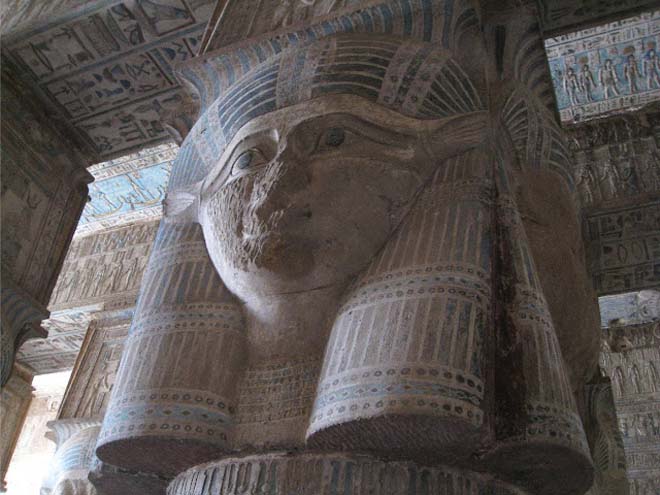
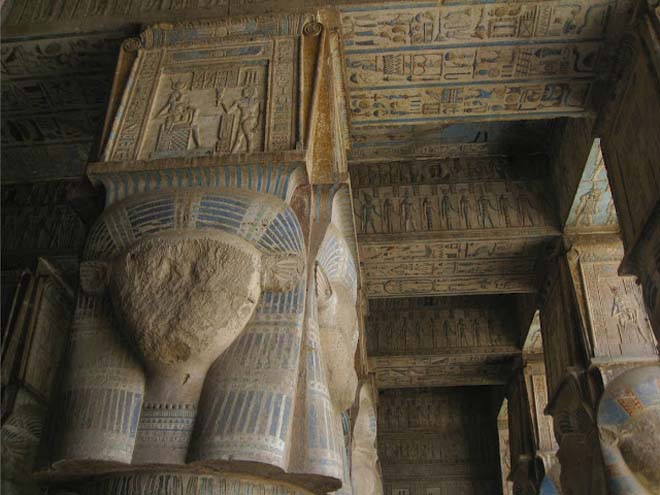
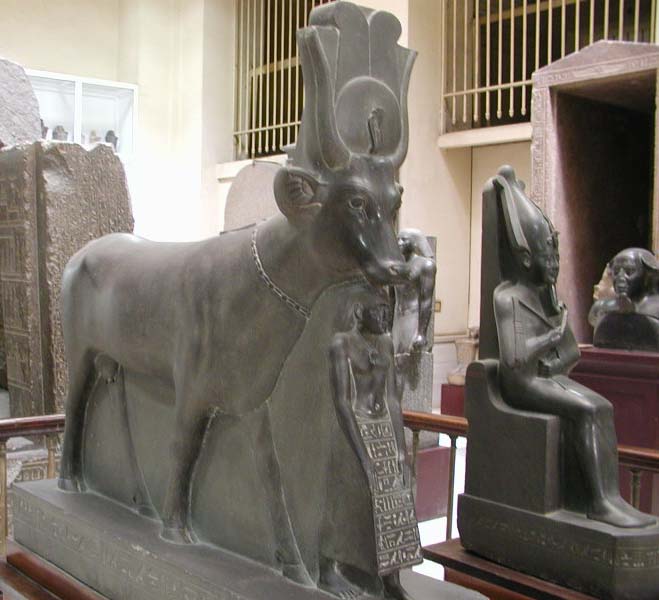
the sun disk, the cobra, as well as her necklace and crown.
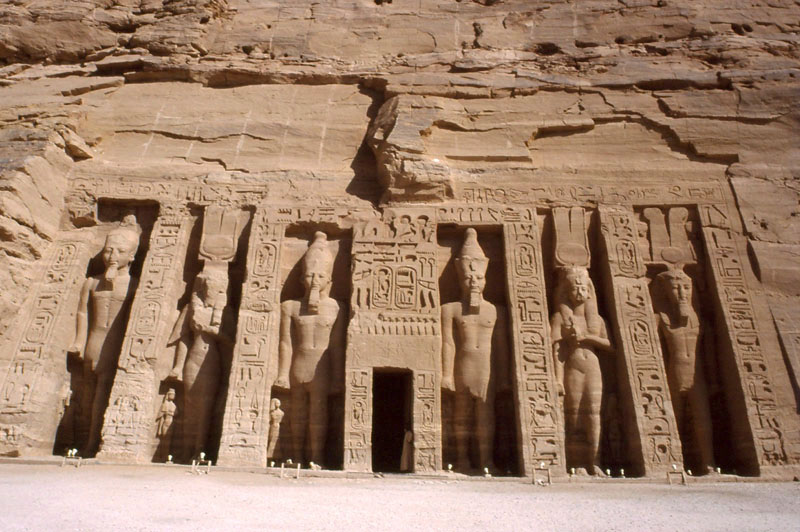
to honor his most love wife Nefertari, Egypt, Africa
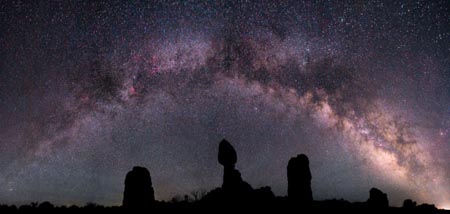
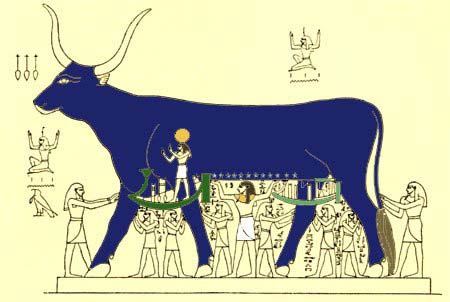
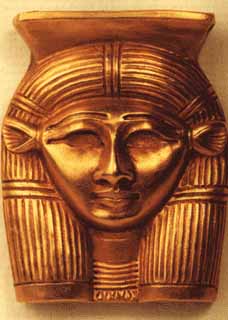
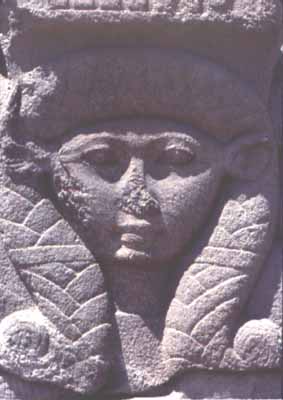
Thou art the Mistress of Jubilation, the Queen of the Dance, the Mistress of Music, the Queen of the Harp Playing, the Lady of the Choral Dance, the Queen of Wreath Weaving, the Mistress of Inebriety Without End.
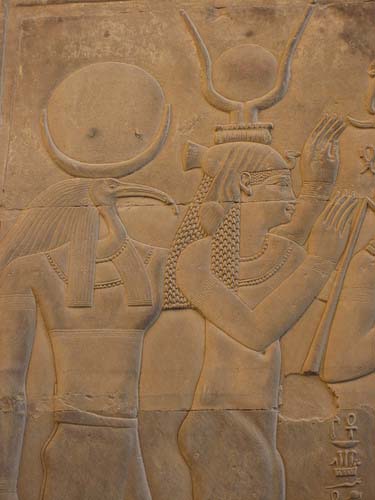
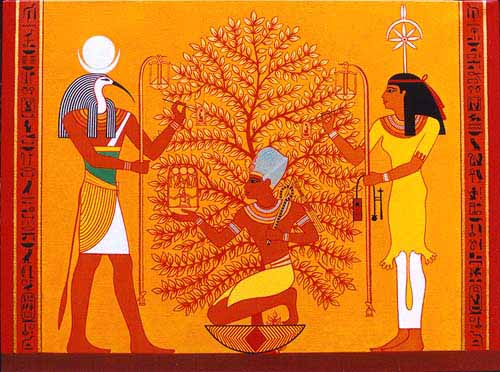
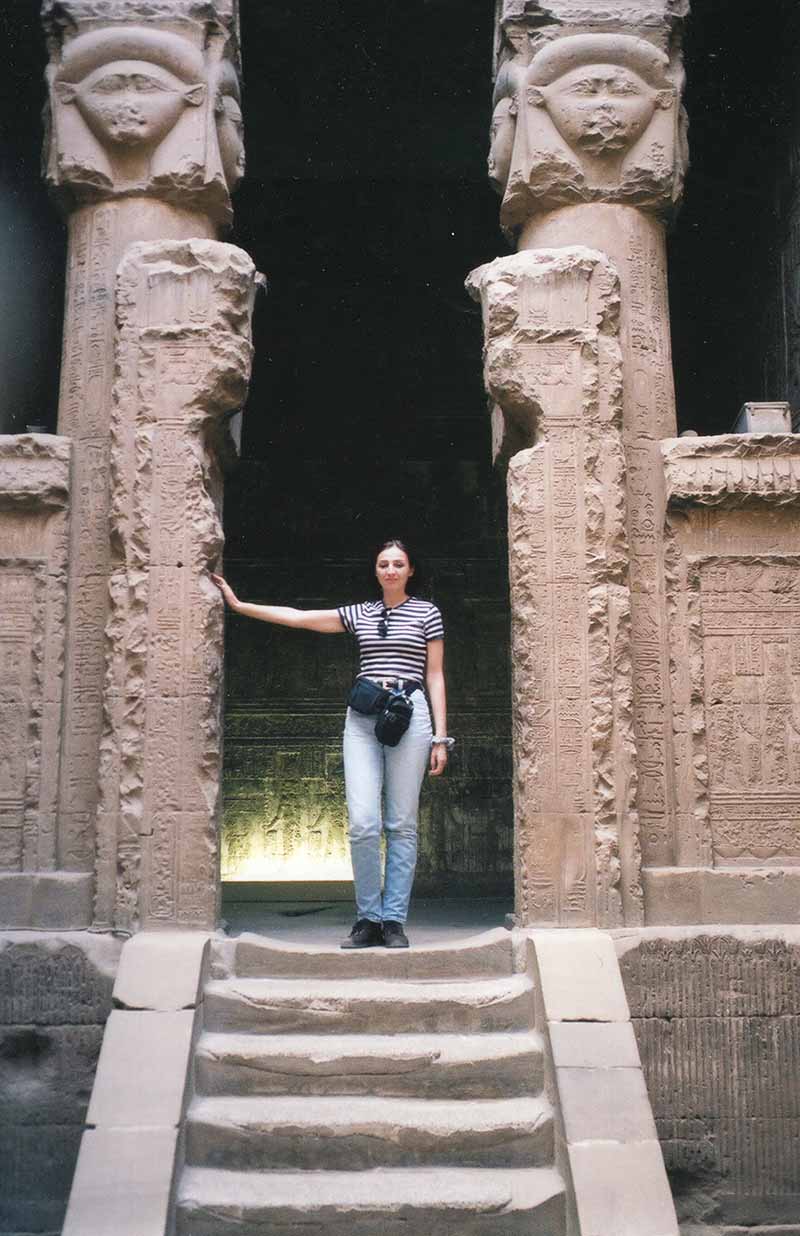
at Dendera when we revisited Egypt.